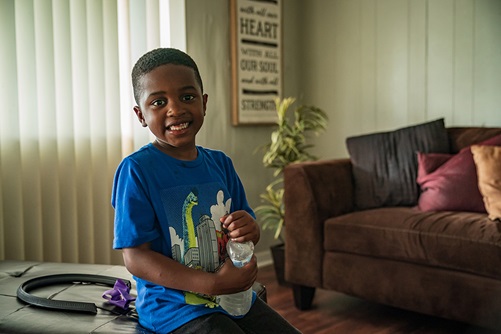 An active 7-year-old who loved performing on TikTok, Major Hudlin suddenly couldn’t lift his right arm or move the fingers on his right hand. His mother, Kenisha Aldridge, immediately drove him to the hospital emergency room near their home in Wharton, Texas. From there, he was helicoptered to the Level 1 pediatric trauma center at Children’s Memorial Hermann Hospital, where he was diagnosed with a stroke.
An active 7-year-old who loved performing on TikTok, Major Hudlin suddenly couldn’t lift his right arm or move the fingers on his right hand. His mother, Kenisha Aldridge, immediately drove him to the hospital emergency room near their home in Wharton, Texas. From there, he was helicoptered to the Level 1 pediatric trauma center at Children’s Memorial Hermann Hospital, where he was diagnosed with a stroke.
Major suffers from sickle cell disease, an inherited disorder in which red blood cells become crescent-shaped, hindering their movement through small blood vessels—a condition commonly resulting in stroke. After a week in intensive care, he was transferred to TIRR Memorial Hermann’s new pediatric inpatient unit to begin rehabilitation.
“He came to us with significant right-sided hemiparesis,” said affiliated physician Stacey Hall, DO, a pediatric physiatrist and clinical assistant professor of pediatric rehabilitation medicine at McGovern Medical School at UTHealth Houston. In layman’s terms, the right side of his body was completely paralyzed.
Making a game of serious rehabilitation
In addition to helping Major regain the use of his hand and arm, his therapy team also worked to improve his balance, lower-extremity strength, and endurance, all of which had also been affected by the stroke. To restore him to his active self, they took a creative approach.
“We played games within a story Major created for us,” said his physical therapist Amelie Bordelon, PT. “We climbed to the top of ‘Stairwell Mountains’ and drove scooter board ‘race cars’ through obstacle courses.”
Major’s speech and ability to swallow were also affected by the stroke, so the team placed him on a modified diet with supplemental intake through a tube placed past his throat and into his stomach. Thanks to hard work and active engagement during his sessions, they were soon able to remove the tube, allowing him to get back to a regular diet.
Creative strategies to meet verbal challenges
To address the challenge of verbal communication, the team employed melodic intonation, pacing strategies, and syllable segmentation, giving Major more control over his speech patterns. Achieving maximum benefit from any treatment depends heavily on establishing rapport between patient and clinician. Here, it’s a priority.
“Our favorite book was If You Give a Pig a Pancake,” said his speech therapist Sabrina Casso Filoteo. “We created our own similar story about Major’s stay here. He referred to it as ‘our story.’”
Major’s progress was remarkable.
He was walking what are known as community distances by himself, navigating stairs, and readily using his right hand. After two weeks of inpatient care—and two weeks ahead of schedule—he was discharged, continuing his outpatient therapy from home.
“He loved every one of his caregivers at TIRR Memorial Hermann,” said Kenisha. “His strength is improved and he’s back at school, playing with his siblings and making TikTok videos.